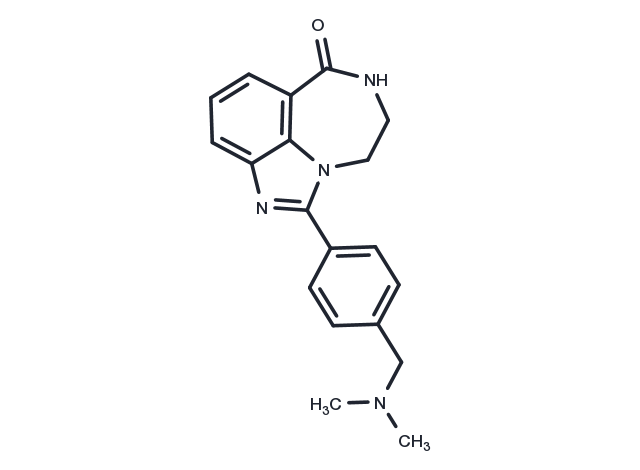Powder: -20°C for 3 years | In solvent: -80°C for 1 year
AG14361 is an effective inhibitor of PARP1 (Ki<5 nM).

| 説明 | AG14361 is an effective inhibitor of PARP1 (Ki<5 nM). |
| ターゲット&IC50 | PARP1:<5 nM(Ki) |
| In vitro | Within non-toxic doses, AG14361 can enhance the growth delay of LoVo xenografts induced by irinotecan, X-ray irradiation, and temozolomide, increasing it by 2 to 3 times. In SW620 xenografts, AG14361 treatment at 10 mg/kg, i.p., for more than 4 hours can inhibit more than 75% of PARP-1 activity. In mice carrying LoVo xenografts, pre-treatment with AG14361 followed by statistical radiation significantly increases sensitivity to radiotherapy. AG14361 can significantly improve blood flow in xenografts, potentially facilitating drug delivery to the tumors. |
| In vivo | AG14361 (0.4 μM) has no impact on cancer cell gene expression or growth but enhances the anti-proliferative activity of temozolomide and topotecan. It also inhibits the recovery of LoVo cells from potentially lethal γ-radiation damage by up to 73%. Despite inhibiting over 85% of PARP-1 activity at 0.4 μM concentration, AG14361 does not affect gene expression or cellular proliferation. It shows no significant impact on the expression of around 6800 genes in A549 cells, even 17 hours post-treatment. At higher concentrations, AG14361 can affect gene expression, but this is not related to the inhibition of PARP-1, as cell proliferation is similarly impacted in both PARP-/- and PARP-1+/+ cells. AG14361 enhances the persistence of DNA single-strand breaks induced by camptothecin and is at least 1,000 times more effective than benzamide. It exerts inhibitory effects on transmembrane SW620 cells (IC50: 29 nM) and intact SW620 cells (IC50: 14 nM). The growth-inhibitory effects of AG14361 are independent of PARP-1 inhibition, as maximal inhibition of PARP-1 occurs at concentrations well below the GI50 (≤1 μM). |
| キナーゼ試験 | PARP-1 Activity Assays: The activity of full-length recombinant human PARP-1 is measured in a reaction mixture containing 20 nM PARP-1, 500 μM NAD+ plus [32P]NAD+ (0.1–0.3 μCi per reaction mixture), and activated calf thymus DNA (10 μg/mL) at 25oC; the reaction is terminated after 4 minutes by adding ice-cold 10% (wt/vol) trichloroacetic acid. The reaction product [32P]ADP-ribose incorporated into acid-insoluble material is deposited onto Whatman GF/C glass fiber filters with a Bio-Dot microfiltration apparatus and quantified with a PhosphorImager. Inhibition of PARP-1 activity by AG14361 at 0–600 nM is measured, and the Ki for AG14361 is calculated by nonlinear regression analysis. |
| 細胞研究 | LoVo and SW620 colorectal cancer cells and A549 non–small-cell lung carcinoma cells are maintained in RPMI-1640 medium containing 10% fetal calf serum. Cell growth inhibition is estimated in exponentially growing LoVo, A549, and SW620 cells in 96-well plates. Cells are exposed to AG14361 (0–20 μM) alone or in the presence of 400 μM temozolomide. After 5 days of culture, these cells are fixed with 10% trichloroacetic acid and stained with sulforhodamine B. The concentration of temozolomide, topotecan, and AG14361 alone or in combination that inhibits growth by 50% (GI50) is calculated from computer-generated curves. Recovery from potentially lethal damage is measured in confluent LoVo cell cultures arrested in G1 phase to mimic the radiation-resistant quiescent cell population in tumors. Such cells are exposed to 8 Gy of γ-irradiation and then harvested and plated for colony formation assay immediately or maintained as growth-arrested confluent cultures for a 4-hour or 24-hour recovery period before harvesting and plating for the colony formation assay. Where indicated, 0.4 μM AG14361 is added 30 minutes before irradiation and is present in the recovery incubation. (Only for Reference) |
| 別名 | AG 14361, AG-14361 |
| 分子量 | 320.39 |
| 分子式 | C19H20N4O |
| CAS No. | 328543-09-5 |
Powder: -20°C for 3 years | In solvent: -80°C for 1 year
DMSO: 10 mg/mL (31.2 mM)
H2O: < 1 mg/mL (insoluble or slightly soluble)
Ethanol: < 1 mg/mL (insoluble or slightly soluble)
You can also refer to dose conversion for different animals. 詳細
bottom
Please see Inhibitor Handling Instructions for more frequently ask questions. Topics include: how to prepare stock solutions, how to store products, and cautions on cell-based assays & animal experiments, etc.
AG14361 328543-09-5 Chromatin/Epigenetic DNA Damage/DNA Repair PARP inhibit Inhibitor AG 14361 poly ADP ribose polymerase AG-14361 inhibitor
